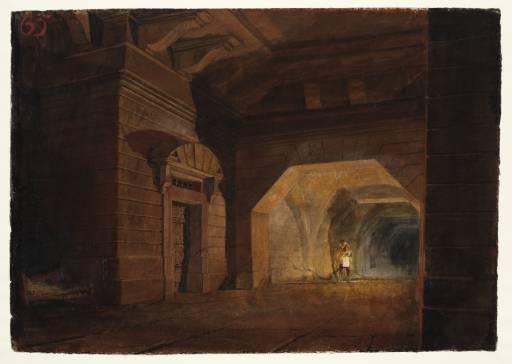Joseph Mallord William Turner Lecture Diagram 65: Interior of a Prison c.1810
Joseph Mallord William Turner,
Lecture Diagram 65: Interior of a Prison
c.1810
Joseph Mallord William Turner 1775–1851
Lecture Diagram 65: Interior of a Prison circa 1810
D17090
Turner Bequest CXCV 120
Turner Bequest CXCV 120
Pencil, watercolour and gouache over transfer ink on white wove paper, 487 x 687 mm
Inscribed by Turner in red watercolour ‘65’ top left
Inscribed by Turner in red watercolour ‘65’ top left
Accepted by the nation as part of the Turner Bequest 1856
Exhibition history
1974
Turner 1775–1851, Royal Academy of Arts, London, November 1974–March 1975 (B54b).
1980
Turner and the Sublime, Art Gallery of Ontario, Toronto, November 1980–January 1981, Yale Center for British Art, New Haven, February–April 1981, The British Museum, London, May–September 1981 (15, reproduced in colour).
1990
The Third Decade, Turner Watercolours 1810–1820, Tate Gallery, London, January–April 1990 (5, reproduced).
1992
Turner as Professor: The Artist and Linear Perspective, Tate Gallery, London, October 1992–January 1993 (11, reproduced in colour).
2007
Hockney on Turner Watercolours, Tate Britain, London, June 2007–February 2008 (no catalogue).
2010
Romantics, Tate Britain, London, August 2010–April 2012 (no catalogue).
References
1909
A.J. Finberg, A Complete Inventory of the Drawings of the Turner Bequest, London 1909, vol.I, p.591, CXCV 120, as ‘Interior of prison: possibly Newgate’.
1974
Martin Butlin, Andrew Wilton and John Gage, Turner 1775–1851, exhibition catalogue, Royal Academy of Arts, London 1974, p.181.
1980
Andrew Wilton, Turner and the Sublime, exhibition catalogue, Art Gallery of Ontario, Toronto 1980, pp.56 reproduced in colour pl.8, 114–5.
1983
Adele M. Holcombe, ‘Turner and the Sublime’, Turner Studies, Vol.3, No.1, Summer 1983, p.52 [previously published in Revue d’art Canadienne/Canadian Art Review, Universities Art Association of Canada].
1987
Andrew Wilton, Turner in his Time, London 1987, p.90 reproduced in colour.
1988
Ian Warrell and Diane Perkins, Turner & Architecture, exhibition catalogue, Tate Gallery, London 1988, p.15 under no.25.
1992
Maurice Davies, Turner as Professor: The Artist and Linear Perspective, exhibition catalogue, Tate Gallery, London 1992, p.23, reproduced in colour fig.11.
1994
Maurice William Davies, ‘J.M.W. Turner’s Approach to Perspective in His Royal Academy Lectures of 1811’, unpublished Ph.D thesis, Courtauld Institute of Art, London 1994, p.263.
2001
Brian Lukacher, Joseph Gandy in the Shadow of the Enlightenment, (Sixth) Annual Soane Lecture, Sir John Soane’s Museum, London 2001, pp.17, 18 reproduced fig.8.
2006
Brian Lukacher, Joseph Gandy: An Architectural Visionary in Georgian England, London 2006, pp.84, 85 reproduced pl.94.
2007
David Blayney Brown, Turner Watercolours, London 2007, p.45 reproduced in colour.
2007
David Blayney Brown, Hockney on Turner Watercolours, London 2007, p.15 reproduced on colour.
Diagram 65 is one of three views of a prison interior prepared by Turner for his lectures as Professor of Perspective at the Royal Academy, from an etching by Giovanni Battista Piranesi (1720–1778) in his Prima Parte de Architettura e Prospettive (1743, pl.2); see also Diagrams 66 and 75 (Tate D17091, D17099; Turner Bequest CXCV 121, 128). They are associated by Maurice Davies with a large group of diagrams illustrating the production of shadows; see note to Diagram 60 (Tate D17085; Turner Bequest CXCV 115). Turner refers to a ‘prison drawing’ in a manuscript titled ‘Lecture upon light, shade and reflexes’1 but it is not clear which one this is.
Piranesi’s images of fantastic prisons exerted a powerful influence on the Romantic imagination, the writer Thomas De Quincey even attributing them to the use of opium – a supposition now generally rejected. In fact, they combined elements familiar from Roman baroque stage design with Piranesi’s interest in the possibilities of masonry engineering and construction, the result of his early training in Venice. Turner, along with his early friend Thomas Girtin, is known to have studied or copied works by Piranesi in the collection of John Henderson; a copy attributed to Turner of the famous ‘Dark Prison’ (Carcere oscura con antenna nel supplizio de’ malfatori) is in the Metropolitan Museum, New York.2 While preparing his Academy lectures, Turner’s interest was refreshed by his friend John Soane, the Professor of Architecture, with whom he shared a critical admiration for the Venetian artist. As well as the prisons, Turner referred to his prints of Roman columns and probably to drawings by him of the Temple of Neptune at Paestum belonging to Soane for his lecture illustrations (Tate D17123, D17124, D17072; Turner Bequest CXCV 152, 153, 102).
Verso:
Blank, save for an inscription in red watercolour ‘65’ top left and by an unknown hand in pencil ‘115’ bottom left
Andrea Fredericksen
June 2004
Supported by The Samuel H. Kress Foundation
Revised by David Blayney Brown
April 2012
How to cite
Andrea Fredericksen, ‘Lecture Diagram 65: Interior of a Prison c.1810 by Joseph Mallord William Turner’, catalogue entry, June 2004, revised by David Blayney Brown, April 2012, in David Blayney Brown (ed.), J.M.W. Turner: Sketchbooks, Drawings and Watercolours, Tate Research Publication, December 2012, https://www

